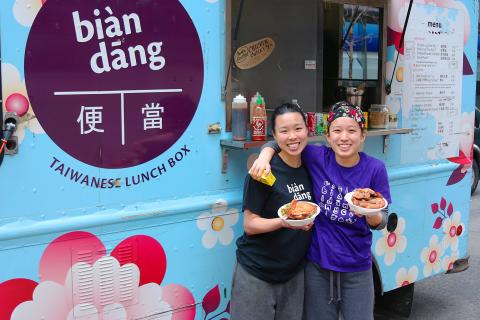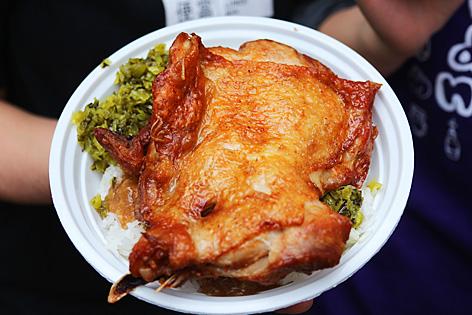When Taiwanese-American Thomas Yang (楊嘉豪) graduated from college in 2008, a stagnated economy offered little hope of finding a job, even with his newly minted bachelor’s degree in accounting. But Yang had something his classmates did not.
“I had a family recipe that I thought was pretty good,” he said.
That and insurance money from his father, a Taiwanese chef who died while Yang was in high school, helped him and his sister, Diana, start New York’s only Taiwanese biandang (便當) food truck, which serves up classics like fried chicken leg over rice (雞腿飯) and fried pork chop over rice (排骨飯) to a hungry midtown lunch crowd.

Photo: Chris Fuchs
“We were one of the first few food trucks,” Diana Yang (楊佩珊) told the Taipei Times. “We didn’t do any research, and it just happened that it worked.”
Thomas said the inspiration for Biandang — the Chinese word used in Taiwan for a take-away box similar to Japan’s bento — came from the Halal food carts outside Baruch College in Manhattan, where the Yangs both studied. (Halal is an Arabic word meaning “permissible” and denotes that the meat conforms to Islamic dietary laws.) The popularity of those NT$150 chicken-and-rice combos, heavily seasoned with middle-eastern spices and topped with iceberg lettuce, tomato and a sweet-and-tangy white sauce, got Thomas thinking about a similar ubiquitous staple of takeout Chinese joints: chicken and broccoli served over rice.
“He was thinking of one day opening Asian carts and taking over Manhattan,” joked Diana.

Photo: Chris Fuchs
FILLING A NICHE
That never happened. But Biandang, which celebrates its fifth anniversary on April 28, has helped fill a void in New York’s Taiwanese food scene. Finding Taiwanese fare among the nearly 6,000 Chinese restaurants in New York is no small task. Flushing, a Queens neighborhood home to many Taiwanese, has around a dozen-or-so Taiwanese restaurants scattered throughout its congested downtown area. And Manhattan and Brooklyn, another borough, have even fewer.
Realizing this, Thomas, who had previously worked on two other trucks, saw the food business as a viable career move in an otherwise sluggish economy. But neither Thomas nor his sister could cook. So they enlisted the help of their uncle, an immigrant from Taiwan who, like their deceased father, was an accomplished chef. In their Brooklyn kitchen, the Yangs’ uncle preps the pork chops and chicken, which are fried-to-order on the truck, as well as other dishes, including zongzi (粽子), sticky rice stuffed with ingredients like radish and mushroom, topped with pork or beans and steamed in a bamboo leaf. The night before heading out, the Yangs load up their truck, which is equipped with a refrigerator and a rice cooker.
At first, it was rough going for the brother-sister team. “When we first started, I parked by Baruch College, and I couldn’t give away free food,” Thomas said. “They would be comparing us to Halal chicken, which is more well known in New York. To them, it was Chinese chicken and rice, and they didn’t want to try it out.”
So the Yangs changed tack. They scrapped the original name of their food truck, Cravings, which some customers errantly assumed served desserts, in favor of the Taiwanese-sounding Biandang. And they also hired a designer to brighten up the truck’s exterior, painting it in a sky blue, dark purple color combination that prominently features Taiwan’s national flower, the plum blossom (梅花).
After some trial and error, and navigating the city’s arcane parking restrictions, the Yangs found a nice nook to dock on E 53rd Street near Park Avenue, where they attract a regular lunch-hour crowd of construction workers, curious passersby and white-collar business types from the nearby office buildings. On a good day, when the weather is nice, Biandang serves as many as 150 customers in two hours, Diana said.
ASIAN DEMOGRAPHIC
But the crowd demographic, she added, still remains heavily skewed — 70 percent Asian, 70 percent male. “I think it’s because it’s heavier food,” she said, referring specifically to the dearth of women customers.
As Yang predicted, those waiting in line last Wednesday were mostly men. But only half were Asian. Debbie Pappas, a regular who is neither, took a drag on a cigarette as she chatted up Biandang worker Joanna Wu (吳昭安), a Taiwanese-American graduate student studying education at nearby Hunter College. Wu was busy deep-frying Pappas’ pork chop.
“Their pork chops are amazing — it’s like crack,” Pappas said, adding that she “loves” the stewed pork sauce poured on the white rice topped with pickled mustard greens.
“At one point, I was eating it everyday. Now I limit it to once or twice a week.”
Patrick Chatkupt, who stopped by around 12:30pm, shortly after Pappas made her way down Park Avenue, said he used to be a weekly regular a few years back, before moving to Connecticut. “That’s probably why I’m gonna have a heart attack in my 40s,” he joked. Down in the city for a meeting, Chatkupt, who comes from Thailand, said he has had Taiwanese-style pork chops elsewhere in New York, but said these were his favorite.
T.J. Caparas, a professional chef who was also in line, agreed. “This is comfort food,” he said. “I would give it an 8 ½” out of 10.
Business has been good for the Yangs, so much so that in the last three years, they have launched two new trucks: Domo Taco, which sells pan-Asian tacos; and Moo Shu Grill, which prepares rice bowls and, of course, Moo Shu (木須), a northern Chinese dish of stir-fried and pickled vegetables, served with a choice of six proteins, and wrapped in a soft tortilla-like shell. All together, the Yangs have a team of between 10 and 15 employees who each must train for a city Mobile Food Vendor License to work on a food truck. Owners can be fined up to the equivalent of NT$30,283 for each employee who lacks a license.
These days, obtaining a New York City Department of Health vehicle permit is tough. The city has already issued nearly all of the 5,100 permits allocated for food trucks and carts and now has a long waiting list for upstarts eager to join the ranks, according to the city’s Department of Consumer Affairs. This, in turn, has created a black market for permits that can each cost up to NT$757,075, published reports said. In 2010, the Public Broadcasting Service (PBS) reported that there were some 10,000 food trucks on the streets of New York — nearly double the number for which permits are allotted.
With half a decade of experience behind them, Biandang runs with speed and efficiency, though it is anything but an assembly-line experience. Besides fried pork chop and fried chicken leg over rice, which they always deliver with a smile to customers in literally a minute, Biandang serves rotating specials like pork belly, which sold out last Wednesday, as well as eight main dishes and appetizers, including Tianbula (甜不辣) fishcakes over rice, pork dumplings (豬肉水餃) and a snack platter of pork sauce poured over rice and accompanied by a stewed boiled egg (滷肉飯加蛋).
Diana said she has considered expanding the menu to include other Taiwanese treats like the oyster omelet (蚵仔煎), a night market staple. She also said she has thought of creating a night market scene similar to Taiwan’s.
“But there are so many regulations and stuff from the cops,” Diana said. “We spoke to other vendors to have a night market, but it never really worked out.”
While recreating Taiwan’s food scene in New York may prove a formidable task, Biandang has been doing its part to educate New Yorkers, and their palates, about the rich culinary traditions for which Taiwan is known throughout Asia.
“I feel here, no one really talks about Taiwan,” Diana said. “They only talk about China.”

May 18 to May 24 Pastor Yang Hsu’s (楊煦) congregation was shocked upon seeing the land he chose to build his orphanage. It was surrounded by mountains on three sides, and the only way to access it was to cross a river by foot. The soil was poor due to runoff, and large rocks strewn across the plot prevented much from growing. In addition, there was no running water or electricity. But it was all Yang could afford. He and his Indigenous Atayal wife Lin Feng-ying (林鳳英) had already been caring for 24 orphans in their home, and they were in

On May 2, Chinese Nationalist Party (KMT) Chairman Eric Chu (朱立倫), at a meeting in support of Taipei city councilors at party headquarters, compared President William Lai (賴清德) to Hitler. Chu claimed that unlike any other democracy worldwide in history, no other leader was rooting out opposing parties like Lai and the Democratic Progressive Party (DPP). That his statements are wildly inaccurate was not the point. It was a rallying cry, not a history lesson. This was intentional to provoke the international diplomatic community into a response, which was promptly provided. Both the German and Israeli offices issued statements on Facebook

Even by the standards of Ukraine’s International Legion, which comprises volunteers from over 55 countries, Han has an unusual backstory. Born in Taichung, he grew up in Costa Rica — then one of Taiwan’s diplomatic allies — where a relative worked for the embassy. After attending an American international high school in San Jose, Costa Rica’s capital, Han — who prefers to use only his given name for OPSEC (operations security) reasons — moved to the US in his teens. He attended Penn State University before returning to Taiwan to work in the semiconductor industry in Kaohsiung, where he

President William Lai (賴清德) yesterday delivered an address marking the first anniversary of his presidency. In the speech, Lai affirmed Taiwan’s global role in technology, trade and security. He announced economic and national security initiatives, and emphasized democratic values and cross-party cooperation. The following is the full text of his speech: Yesterday, outside of Beida Elementary School in New Taipei City’s Sanxia District (三峽), there was a major traffic accident that, sadly, claimed several lives and resulted in multiple injuries. The Executive Yuan immediately formed a task force, and last night I personally visited the victims in hospital. Central government agencies and the